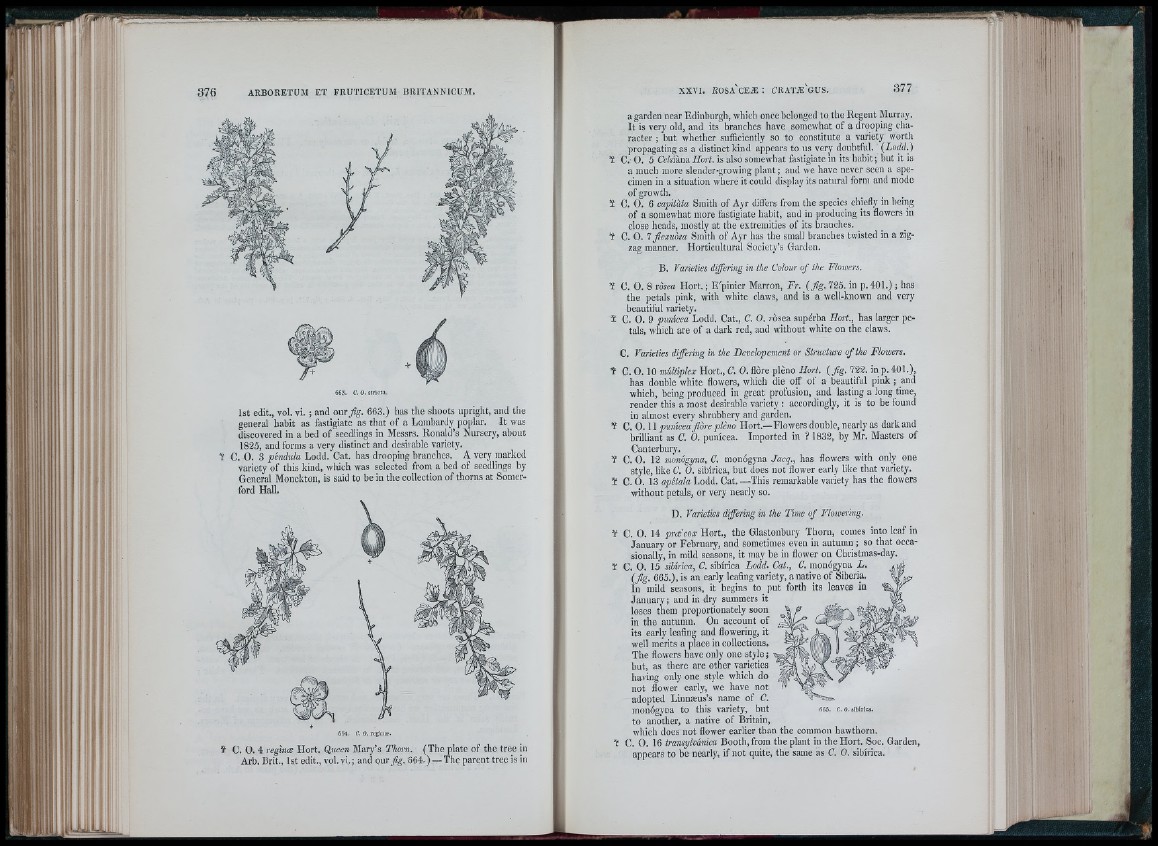
1st edit., vol. vi. ; and our jig . 663.) has the shoots upright, and the
general habit as fastigiate as that of a Lombardy poplar. I t was
discovered in a bed of seedlings in Messrs. Ronald’s Nursery, about
1825, and forms a very distinct and desirable variety.
¥ C. O. 3 péndula Lodd. Cat. has drooping branches. A very marked
variety of this kind, which was selected from a bed of seedlings by
General Monckton, is said to be in the collection of thorns at Somerford
Hall.
¥ C. O. 4 regime Hort. Queen Mary’s Thom. (T he plate of the tree in
Arb. Brit., 1st edit., vol.vi.; and o u r^ g . 864-)-r-The parent tree is in
L
»garden near Edinburgh, which once belonged to the Regent Murray.
I t is very old, and its branches have, somewhat of a drooping character
; but whether sufficiently so to constitute a variety worth
propagating as a distinct kind appears to us very doubtful. {Lodd.)
15 C. O, 5 Ct'/siana Hort. is also somewhat fastigiate in its habit ; but it is
a much more slender-growing plant ; and we have never seen a specimen
in a situation where it could display its natural form and mode
of growth.
15 C. O. 6 capitata Smith of Ayr differs from the species chiefly in being
of a somewhat more fastigiate habit, and in producing its flowers in
close heads, mostly at the extremities of its branches.
15 C. O. 7 flexuòsa Smith of Ayr has the small branches twisted in a zigzag
manner. Horticultural Society’s Gaixlcn.
B, Vaiieties differing in the Colour of the Flowers.
15 C. O. 8 vòsea H o rt.; E'pinier Marron, Fr. {flg .1 2 5 . in p .401.) ; has
the petals pink, with white claws, and is a well-known and very
beautiful variety,
15 C. O. 9 punicea Lodd. Cat., C. O. ròsea supèrba Hort., has larger petals,
which are of a dark red, and without white on the claws.
C. Varieties differing in the Developement or Structure of the Flowers.
t C .O . 10 multiplex Hort., C. 0 . flòre pièno Hort. {flg . 722. in p. 401.),
has double white flowers, which die off of a beautiful pink ; and
which, being produced in great profusion, and lasting a long time,
render this a most desirable variety : accordingly, it is to be found
in almost every shrubbery and garden.
15 C. 0 . 11 punicea flòre pièno Hort.—Flowers double, nearly as dark and
brilliant as C. O. punicea. Imported in ? 1832, by Mr. Masters of
Canterbury.
¥ C. O. 12 monógyna, C. monógyna Jacq., has flowers with onl)^ one
style, like C. O. sibirica, but does not flower early like that variety,
15 C. O. 13 apetala Lodd. Cat. — This remai’kable variety has the flowers
without petals, or very nearly so.
D. Varieties differing in the Time of Floivering.
Y C. O. 14 prwcox Hort., the Glastonbury Thorn, comes into leaf in
January or February, and sometimes even in autumn ; so th a t occasionally,
in mild seasons, it may be in flower on Christmas-day.
¥ C. O. 15 sibirica, C, sibirica Lodd. Cat., C. monogyna L,
(fig. 665.), is an early leafing variety, a native of Siberia.
In mild seasons, it begins to put forth its leaves in
January; and in dry summers it
loses them proportionately soon
in the autumn. On account of
its early leafing and flowering, it
well merits a place in collections.
The flowers have only one style ; ■
but, as there are other varieties
having only one style which do
not flower early, we have not
adopted Linnaeus’s name of C.
monógyna to this variety, ^ but
6C5. C. 0 - sibirica.
to another, a native of Britain,
which does not flower earlier than the common hawthorn.
t C. O. 16 transylvanica Booth, from the plant in the H ort. Soc. Garden,
appears to be nearly, if not quite, the same as C. 0 . sibirica.